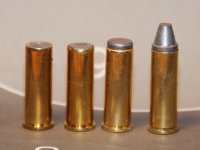elpac3
Member
Did some range test firing this past weekend with some 148 grain, .38 loads. Tested 3 bullets in 4 configurations.
The bullets were:
Hornaday 148 grain hollow base wadcutter sized to .358"
Rim Rock 148 grain double ended wadcutter sized to .358"
Rim Rock 148 grain semi wadcutter sized to .358"
Bullet lengths were:
Hornaday HBWC = .630"
Rim Rock DEWC = .572" (.475" to the crimp groove)
Rim Rock SWC = .358" to the crimp groove
All bullets were loaded on Federal .38 special brass cases, loaded with 2.8 grains of Bullseye powder.
Test firing was done at a 50 foot target from a bench with a S&W model 14-3, 6" barrel with a Bomar rib and chronographed with a magneto speed chronograph.
Results were:
Hornaday HBWC, case mouth flush, taper crimp = 804 fps
Rim Rock DEWC, case mouth flush, taper crimp = 839 fps
Rim Rock DEWC, crimped in crimp groove = 785 fps
Rim Rock, SWC crimped in crimp groove = 742 fps
Group sizes measured:
Hornaday HBWC, flush seated = .73"
RR DEWC flush seated = 1.6"
RR DEWC crimped in crimp groove = .9"
RR SWC crimped in crimp groove = .75"
Velocities varied as the case volume changed with the bullet seating depth as would be expected. The DEWC seated case mouth flush provided the smallest case volume which in turn provided the highest velocity while the SWC provided the greatest case volume and produced the lowest velocity.
The take aways were:
1. Not all 148 grain wad cutter bullets will produce the same velocity given the same powder charge (expeced since the HBWC provides for a larger case volume when seated than the DEWC when seated)
2. Seating depth has a marked influence on velocity (and like wise on pressure - although pressure was not measured)
3. Shooting with a chronograph adds a whole new dimension to reloading and load development
The bullets were:
Hornaday 148 grain hollow base wadcutter sized to .358"
Rim Rock 148 grain double ended wadcutter sized to .358"
Rim Rock 148 grain semi wadcutter sized to .358"
Bullet lengths were:
Hornaday HBWC = .630"
Rim Rock DEWC = .572" (.475" to the crimp groove)
Rim Rock SWC = .358" to the crimp groove
All bullets were loaded on Federal .38 special brass cases, loaded with 2.8 grains of Bullseye powder.
Test firing was done at a 50 foot target from a bench with a S&W model 14-3, 6" barrel with a Bomar rib and chronographed with a magneto speed chronograph.
Results were:
Hornaday HBWC, case mouth flush, taper crimp = 804 fps
Rim Rock DEWC, case mouth flush, taper crimp = 839 fps
Rim Rock DEWC, crimped in crimp groove = 785 fps
Rim Rock, SWC crimped in crimp groove = 742 fps
Group sizes measured:
Hornaday HBWC, flush seated = .73"
RR DEWC flush seated = 1.6"
RR DEWC crimped in crimp groove = .9"
RR SWC crimped in crimp groove = .75"
Velocities varied as the case volume changed with the bullet seating depth as would be expected. The DEWC seated case mouth flush provided the smallest case volume which in turn provided the highest velocity while the SWC provided the greatest case volume and produced the lowest velocity.
The take aways were:
1. Not all 148 grain wad cutter bullets will produce the same velocity given the same powder charge (expeced since the HBWC provides for a larger case volume when seated than the DEWC when seated)
2. Seating depth has a marked influence on velocity (and like wise on pressure - although pressure was not measured)
3. Shooting with a chronograph adds a whole new dimension to reloading and load development
Attachments
Last edited:







